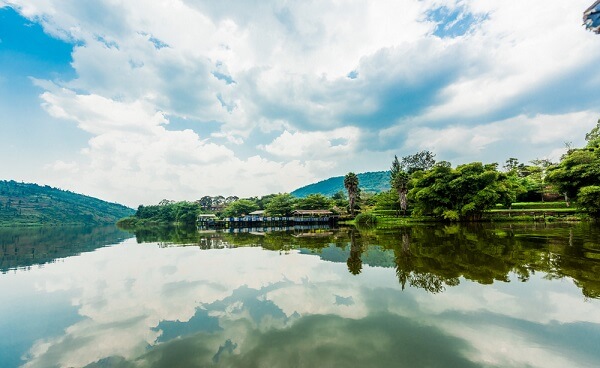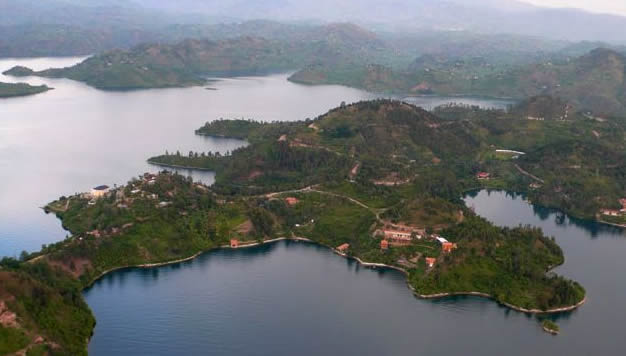
Explore Spontaneous Lakes in Rwanda
Explore Spontaneous Lakes in Rwanda: Rwanda Lakes, located away from the major resorts, provides guests with a delightful look into traditional African lifestyles. Fishermen ply the river in centuries-old dugout boats, while colorfully costumed ladies smoke ancient wooden pipes and troubadours play softly on stringed iningire (traditional ‘guitars’). Flotillas of pelicans cruise ponderously over the open lake, stately crowned cranes preen their golden crests in the surrounding marshes, and jewel-like malachite kingfishers hawk softly above the coast.
Lake Kivu
Lake Kivu, located in western Rwanda, is part of Africa’s Great Rift Valley and features deep emerald green waters with a surface area of 2,700 km2. It is Rwanda’s biggest lake and Africa’s sixth largest.
Lake Kivu is the largest of several freshwater lakes that glisten amid Rwanda’s lowlands. The lake is a popular weekend destination for Rwandans, with families and friends enjoying relaxed days on the beach, water sports including as kayaking, canoeing, and windsurfing, and beach volleyball. Take a leisurely voyage along the country’s western shoreline aboard the “Munezero” tourist boat from Gisenyi to Kibuye to Cyangungu, a trip you’ll never forget.
From Rubavu in the north to Rusizi in the south of Lake Kivu, the Congo Nile Trail spans 227 kilometres of beautiful scenery. The track softly bends back and forth as it twists between hills and mountains near the lake, lined with eucalyptus trees and appearing terraced with bananas on every inch of the slopes.
A kayaking excursion on Lake Kivu, or mountain biking or trekking one of the six off-the-beaten-path sections of the beautiful Congo Nile Trail, are thrilling ways for adventurous travellers to see Rwanda.
Lake Burera and Ruhondo
The Twin Lakes are located in northeastern Rwanda, close to Uganda and the Virunga volcanoes. They are at various heights and are separated by a stripe of mountains only 600m/1,958ft wide. The 98m/322ft differential is significant enough that a hydropower plant may use it to generate energy. The water enters the lakes via an underground tunnel named Ntaruka, which was built by the Belgians in 1959.

Ntaruka is now a type of gateway to both Lake Burera and Lake Ruhondo. It serves as a viewing spot as well as a parking lot for persons enjoying boat trips. From here, travellers may explore the Ruhondo wetland, where they can observe cranes, blue spoonbills, and other species.
Lakes Burera and Ruhondo, near the gorilla tracking hub of Ruhengeri, are often overlooked treasures, with deep blue lakes bordered by steep slopes and big waterfalls, with the adjacent Virunga Volcanoes providing a stunning backdrop, Explore Spontaneous Lakes in Rwanda
Lake Muhazi
Lake Muhazi is a Kinyarwanda name for a narrow, shallow lake on Rwanda’s eastern border. This is also known as a flooded valley lake, and it runs east and west. This lake also features a concrete dam at the west end, which was built in 1999 to replace an earth dam that existed previously. This lake also discharges its water into the Nyabugogo River, which runs south of Kigali and merges with the “Nyabarongo River.”
Lake Muhazi, about an hour and a half from Kigali, is one of Rwanda’s picturesque beauties. This calm cove in Rwanda’s eastern region is great for a day excursion away from the city, where you can eat fresh fish and watch the sun set over the little boats dotting the lake, Explore Spontaneous Lakes in Rwanda
This lake is easily accessible via three major Rwandan routes: the Gatuna road, which runs along the lake’s western shore, the Kyonza road, which runs along to the lake’s southern shore, and the 3.8-kilometer-long Kagitumba road. Lake Muhazi is likewise 60 kilometres long and 5 kilometres wide, spanning five provinces in Rwanda: Kigali, Eastern Province, Northern Province, Rwamagama District, Kayonza District, and Gatsibo District in the north.
Akagera National Park features 10 lakes, some of which serve as drinking holes for animals and others as havens for birdwatchers—the uncommon shoebill stork lives in Akagera’s lakes. Malachite king fishers, pied king fishers, African fish eagles, arrow marked, black lured, swamp flycatchers, village weavers, African paradise fly catchers, bronze, scarlet chested, white breasted cormorants, yellow fronted canaries, yellow billed storks, open bill, cattle egrets, and grey crowned cranes are among the bird species found in the lake.
There are also several fish species, such as marbled lung fish and Tilapia. This lake is particularly well-known for tourism since it is home to two major resorts, including the Seeds of Peace Center, which provides lodging and a beach. Tourists visiting Rwanda utilize these as stopovers on their way to and from the Akagera National Park, which is well-known for its animal watching. It also provides opportunities for bird viewing, fishing, and boating. The Rwesero beach, located on the park’s north eastern beaches, provides guests with camping amenities.
Contact us at Explore Rwanda Tours if you are looking to combine your gorilla safari in Rwanda with any of the above lakes.


